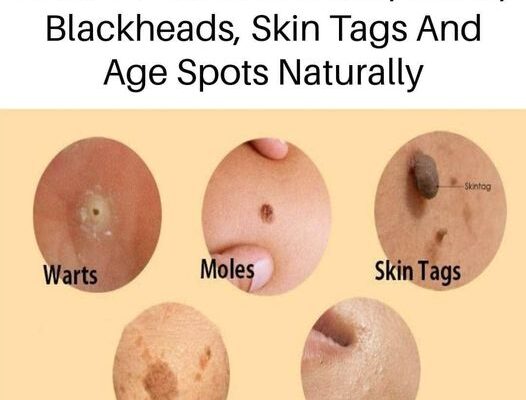There is a lot of pressure in today’s society to have a perfect, flawless complexion. Culturally things like age spots, moles, skin tags, blackheads, and warts are simply not desirable. While there are many remedies that your doctor or dermatologist can give you for these things, natural skin care products and techniques can be just as effective for much lower cost and fewer side effects. This is how to take care of these common skin problems naturally.
Natural Skin Care For Common Skin Problems
For many skin problems, there are treatments available from your doctor or dermatologist that are very effective. The only problem is that they can be costly and can even sometimes do damage to the healthy skin around them. Perhaps these traditional treatments can even leave scars. Thankfully, natural skin care has many options to first try to address these conditions at home before. As always, monitor your skin for signs of unwanted side effects. If the problem doesn’t go away, go see your doctor or dermatologist.
Age Spots and Hyperpigmentation

Over the course of our lives, we are exposed to many elements. The most prominent of those is our own sun. Though we need sunshine for our health, the sun’s ultraviolet (UV) rays can be highly damaging to the skin. Often that damage we don’t see until decades later, in the form of what colloquially we call age spots. Age spots are simply hyperpigmentation of the skin, aka the darkening of certain patches or spots, caused by sun exposure and damage.
The first, and most important, aspect of age spots is prevention. From the time you are young, you should be using sunscreen with a minimum SPF (sun protection factor) of 30 every day, even in the winter and when it’s cloudy. On top of that, you should be wearing sun-protective clothing, like hats and sunglasses. Once you’ve already got some age spots showing up, however, there are a few natural skin care remedies that you can use to help decrease them.
Apple Cider Vinegar: Studies show that the acetic acid in apple cider vinegar (AVC) may lighten skin pigmentation. To use ACV on the skin, you first need to combine it with equal parts water, otherwise, it will be too harsh. Apply the mixture to dark patches and leave on for two to three minutes. Rinse thoroughly with lukewarm water and repeat twice daily. (1)
Aloe Vera: A 2012 study found that the aloin in aloe vera is a natural depigmentation compound. Apply to the affected areas before bed and rinse off the next morning. (2)
Green Tea Extract: Research shows that green tea extract can provide effective depigmentation for the skin. Purchase green tea extract and apply according to the directions. Some say you can use green tea bags, but there isn’t any evidence that this actually works. (3)
Black Tea: A study done on guinea pigs found that black tea lightened dark spots. There have been no human studies. If you wish to try, soak black tea leaves in a cup of boiling distilled water for two hours. Strain and use a cotton ball to apply to your face once per day. (4)
Licorice extract: This extract has been shown to lighten hyperpigmentation caused by sun exposure. This is because of its specific active ingredients. Look for licorice-containing creams and apply as directed. (5)
Orchid Extracts: Apply orchid extracts to dark spots for eight weeks noticeably reduced the size and appearance of them. You can find products that contain orchid extract, such as masks, creams, and scrubs. (6)
Lactic Acid Peels: Lactic acid, which is found in milk products, is an effective lightening agent. It works like a glycolic peel but is better for sensitive skin. You will need to apply sunscreen after often after a lactic acid peel. It is also not recommended for people with eczema, rosacea, or psoriasis. (7)
There are other options as well, including retinol-based skin care products or those containing hyaluronic acid. You can also see a dermatologist about medical procedures such as microdermabrasion, freezing (cryotherapy), chemical peels, and laser treatment. These should all be done by licensed dermatologists. (8)
Skin Tags
Skin tags are non-cancerous, soft growths on the skin. They are caused by loose collagen fibers that become lodged inside thicker areas of the skin. Usually, they form in the folds of the skin, such as the folds of the neck, armpits, breasts, groin, and eyelids. They are fairly common, and also fairly easy to remove, should you wish to. Most of the time you can safely remove them at home without having to go to the doctor. It is important to note that home remedies can take longer to produce results than going and seeing a doctor. Do not ever try to speed up the process by cutting off a skin tag yourself. You can cause bleeding, infections, and scarring.
Tea Tree Oil: Tea tree oil is a brilliant antifungal and antiviral agent. It is safe to use on the skin, but you have to dilute it in a carrier oil otherwise it is too strong and can damage your skin. Dilute a few drops into a neutral oil and using a Q-tip gently rub it on the skin tag before bed. Cover it with a bandaid overnight. Continue this until the skin tag dries up and falls off. (9)
At-home freezing kits: You can purchase at-home skin tag removal kits. These kits use cryotherapy, which is when you freeze off the unwanted growth. Use according to the package directions. If it doesn’t work, then go speak to your doctor.
Always be careful when applying things like tea tree oil or freezing agents to the skin. Remember, the goal is to remove the unwanted skin tag – not damage the healthy skin around it in the process. Monitor how your skin reacts to certain products and treatments. If it becomes red, irritated, and inflamed, stop using that product and go speak with your doctor.
Warts

Warts are harmless growths on the skin caused by human papillomavirus (HPV) infections. Though harmless, they are contagious, can be uncomfortable, and are also not very pretty to look at. If you go to your doctor, he will likely prescribe freezing, chemical peels, surgery, or laser surgery. These can be pricey, however, and can cause skin irritation. There are some natural skin care remedies you can try at home, however.
Apple Cider Vinegar (ACV): ACV has shown that it can fight warts for several reasons. First of all, the acetic acid in ACV can kill some bacteria and viruses. The vinegar burns and slowly destroys the infected skin. The wart then eventually falls off. Irritation from the acid also stimulates the immune system to come and fight the virus in that area. More studies, however, are required to confirm its effectiveness. Always dilute the ACV in water before using it. (10)
Bee Propolis: Bees produce a substance called propolis. It is a mixture of pollen, beeswax, bee enzymes, and plant substances. Researchers have found that propolis not only has antiviral properties but that it also promotes skin cell production. This is why many use it to treat acne, wounds, and HPV – the virus that causes warts. Apply propolis to the wart and bandage it overnight. Repeat daily until the wart is gone. (11)
Duct Tape: Some research has shown that duct tape can remove the infected skin overtime. To use it, stick a small piece of duct tape on the wart. Every three to six days, remove it. Soak the wart in water and gently scrub it with a pumice stone or emery board. Leave it uncovered for 10 to 12 hours and repeat. (12)
As always, monitor for any adverse reactions, even when using natural skin care remedies. They can still cause irritation. Also, these remedies only apply to non-genital warts. If you have genital warts, you need to see your doctor.
Blackheads

Blackheads are the most common form of acne – most people have at least a few of them on their skin, particularly the forehead, nose, and chin. This is known as the “T-zone” and is typically the oiliest place on the face. They are formed by the combination of dead skin and excess oil production. They are black because, unlike white heads which create closed pores, blackheads create open ones. This allows oxygen to enter and cause oxidation, which creates a dark color. (13)
Many people find they are tempted to try and squeeze the blackheads out. Dermatologists recommend against this, however. It doesn’t really work and it causes unnecessary damage to your skin. Thankfully, there are plenty of over-the-counter treatments as well as natural skin care remedies that can reduce the number and appearance of blackheads.
Salicylic acid: Use a cleanser with salicylic acid in it. It will treat both white and blackheads because it breaks down the dead skin and excess oil that cause them. It will also remove other daily dirt, oil, and makeup.
AHAs and BHAs: These are alpha and beta-hydroxy acids. Exfoliating with them will help to remove the dead skin cells that clog your pores in the first place. Though exfoliating is not recommended for inflammatory acne, for blackheads it works very well. Glycolic acid is the most common AHA, and salicylic acid is the most common BHA. These are great for anti-aging, as well. You should exfoliate no more than twice per week and always use sunscreen to protect your skin.
Topical retinoids: Retinoids help to unclog stubborn-clogged pores. This is a strong exfoliant, however, and therefore is not recommended if you have sensitive skin.
Clay Masks: Clay masks are brilliant for drawing oils and toxins out of the skin, and are especially effective for those with oily skin. Many also contain sulfur, which helps to break down dead skin cells so that they don’t clog your pores. This is a once-a-week addition to your exfoliating routine.
Charcoal Masks: Charcoal works in very similar ways to clay masks. Some say they work even deeper into the pores than clay to pull out oils and impurities.
Baking soda and water: Baking soda can act as a gentle exfoliate to the skin, which can help remove pore-clogging dead skin cells. Mix baking soda into the water to form a paste and gently massage over your face. Rinse completely and continue with the rest of your skincare routine.
Especially when trying new skin care products, always patch-test first somewhere that the skin isn’t visible. Everyone’s skin is different and what might have worked miracles for your best friend may cause major irritation for you. Patch test first, and then if by several hours to a day later you have no irritation, go ahead and try it on your skin. Don’t try things like pore strips or at-home extraction kits. These can damage the skin and also often remove good things for your skin as well as the bad. Also, don’t be fooled by anything that says “antibacterial or anti-inflammatory” for blackheads. Remember, blackheads are caused by dead skin cells and oil build-up, not bacteria and inflammation.
References
1. “[Use of organic acids in acne and skin discolorations therapy].” NCBI. Alicja Kapuścińska and Izabela Nowak. March 2015.
2. “On The Novel Action of Melanolysis by a Leaf Extract of Aloe vera and Its Active Ingredient Aloin, Potent Skin Depigmenting Agents.” Thieme. Sharique A. Ali, et al. 2012.
3. “Cosmeceuticals for Hyperpigmentation: What is Available?” NCBI. Rashmi Sarkar, et al. January 2013.
4. “Whitening Effect of Black Tea Water Extract on Brown Guinea Pig Skin.” NCBI. So-Young Choi and Young-Chul Kim. September 2011.
5. “What Are Licorice Root’s Benefits and Downsides?” Healthline. Kelli McGrane, MS, RD. June 12, 2020.
6. “Whitening efficacy of plant extracts including orchid extracts on Japanese female skin with melasma and lentigo senilis.” NCBI. Taketsugu Tadokoro, et al. June 2010.
7. “Everything You Need to Know About Lactic Acid Peels.” Healthline. Kristeen Cherney. March 7, 2019.
8. “How to remove solar lentigines.” Medical News Today. Lydia Kibet. February 6, 2022.
9. “Can You Use Tea Tree Oil for Skin Tags?” Healthline. Corinne O’Keefe Osborn. March 8, 2019.
10. “Can You Remove Warts with Apple Cider Vinegar?” Healthline. Jacquelyn Cafasso. April 30, 2019.
11. “The Benefits and Uses of Propolis.” Healthline. Rena Goldman. September 28, 2018.
Wiley
12. “12 Ways to Get Rid of Blackheads.” Healthline. Kristeen Cherney and Dana Robinson. June 24, 2020.



